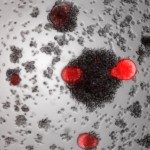Link to Pubmed [PMID] – 32726355
Link to DOI – 10.1371/journal.ppat.1008737
PLoS Pathog. 2020 07; 16(7): e1008737
The severe acute respiratory syndrome coronavirus-2 (SARS-CoV-2) is responsible for the current COVID-19 pandemic. An unbalanced immune response, characterized by a weak production of type I interferons (IFN-Is) and an exacerbated release of proinflammatory cytokines, contributes to the severe forms of the disease. SARS-CoV-2 is genetically related to SARS-CoV and Middle East respiratory syndrome-related coronavirus (MERS-CoV), which caused outbreaks in 2003 and 2013, respectively. Although IFN treatment gave some encouraging results against SARS-CoV and MERS-CoV in animal models, its potential as a therapeutic against COVID-19 awaits validation. Here, we describe our current knowledge of the complex interplay between SARS-CoV-2 infection and the IFN system, highlighting some of the gaps that need to be filled for a better understanding of the underlying molecular mechanisms. In addition to the conserved IFN evasion strategies that are likely shared with SARS-CoV and MERS-CoV, novel counteraction mechanisms are being discovered in SARS-CoV-2-infected cells. Since the last coronavirus epidemic, we have made considerable progress in understanding the IFN-I response, including its spatiotemporal regulation and the prominent role of plasmacytoid dendritic cells (pDCs), which are the main IFN-I-producing cells. While awaiting the results of the many clinical trials that are evaluating the efficacy of IFN-I alone or in combination with antiviral molecules, we discuss the potential benefits of a well-timed IFN-I treatment and propose strategies to boost pDC-mediated IFN responses during the early stages of viral infection.


